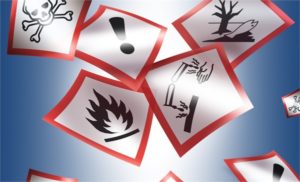 Since 2013, companies have had to make changes to their hazard communication program and training. June 1, 2016 marks the final phase in OSHA’s HazCom/GHS revisions. Employers are required to update all chemical labeling, provide access to updated safety data sheets, revise their hazard communication program to reflect the new changes, and ensure all employees are trained to recognize the new labeling requirements, pictograms, safety data sheet format, physical and health hazards, and how to properly handle the chemicals they work with. Additionally, all chemical manufacturers, importers, and distributors are to follow the new Globally Harmonized System which includes criteria for hazard classification and evaluation, labeling requirements and safety data sheet formatting.
Since 2013, companies have had to make changes to their hazard communication program and training. June 1, 2016 marks the final phase in OSHA’s HazCom/GHS revisions. Employers are required to update all chemical labeling, provide access to updated safety data sheets, revise their hazard communication program to reflect the new changes, and ensure all employees are trained to recognize the new labeling requirements, pictograms, safety data sheet format, physical and health hazards, and how to properly handle the chemicals they work with. Additionally, all chemical manufacturers, importers, and distributors are to follow the new Globally Harmonized System which includes criteria for hazard classification and evaluation, labeling requirements and safety data sheet formatting.
Ask yourself these questions:
- Is your hazard communication program updated?
- Do all of your safety data sheets follow the new 16 section format?
- Are all of your employees trained in the new safety data sheet format, labeling requirements, and pictograms?
- Are your employees aware of the physical and health hazards related to the chemicals they work with?
If you answered “no”, “maybe” or “I don’t know” to any of the above questions, keep reading. OSHA’s Hazard Communication/Globally Harmonized System implementation is in full effect.
The revised standard is aligned with the United Nations Globally Harmonized System of Classification and Labelling of Chemicals (GHS), Revision 3. The goal of the HazCom/GHS standard is to provide employers and workers with sufficient information to recognize, anticipate, evaluate and control chemical hazards related to chemical injuries and illnesses. Employers and workers will also be able to take proactive measures to ensure workplace chemical safety.
As a reminder, the major changes to the Hazard Communication Standard include:
- Hazard classification: Chemical manufacturers and importers are required to determine the hazards of the chemicals they produce or import. The revised standard addresses health and physical hazards as well as classification of chemical mixtures.
- Labels: Chemical manufacturers and importers must provide a label that includes a signal word, pictogram, hazard statement, and precautionary statement for each hazard class and category.
- Safety Data Sheets: There are 16 sections included in a certain format to provide consistency in the way information is presented. The more pertinent information is listed first.
- Information and training: Employees are required to be trained in the new safety data sheet format, labeling requirements and health/physical hazards of the chemicals they work with.
OSHA will not be lenient when it comes to hazard communication violations, especially since companies have had almost three years to comply. SRP Safety Consultants have vast experience in developing hazard communication programs specific to companies, training employees on the revised standard, and verifying chemical labeling and inventory compliance. We provide a turnkey approach to ensure environmental and safety compliance. Have questions? Call SRP today at (318) 222-2364.

 ">
">
 ">
">